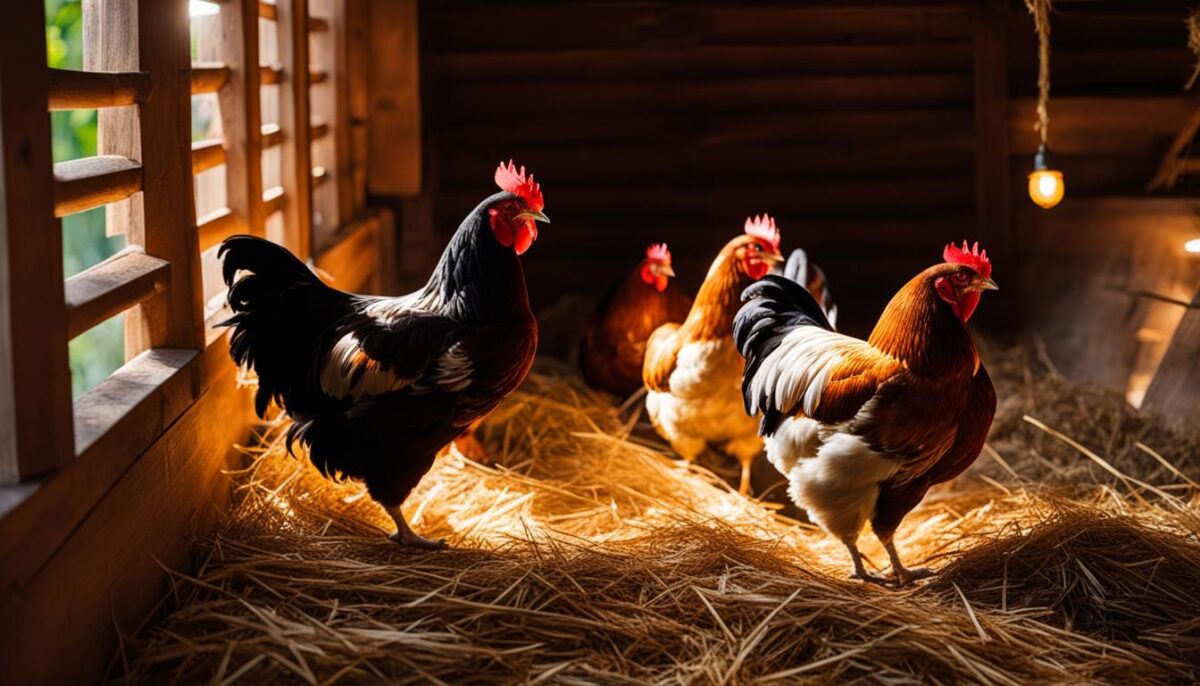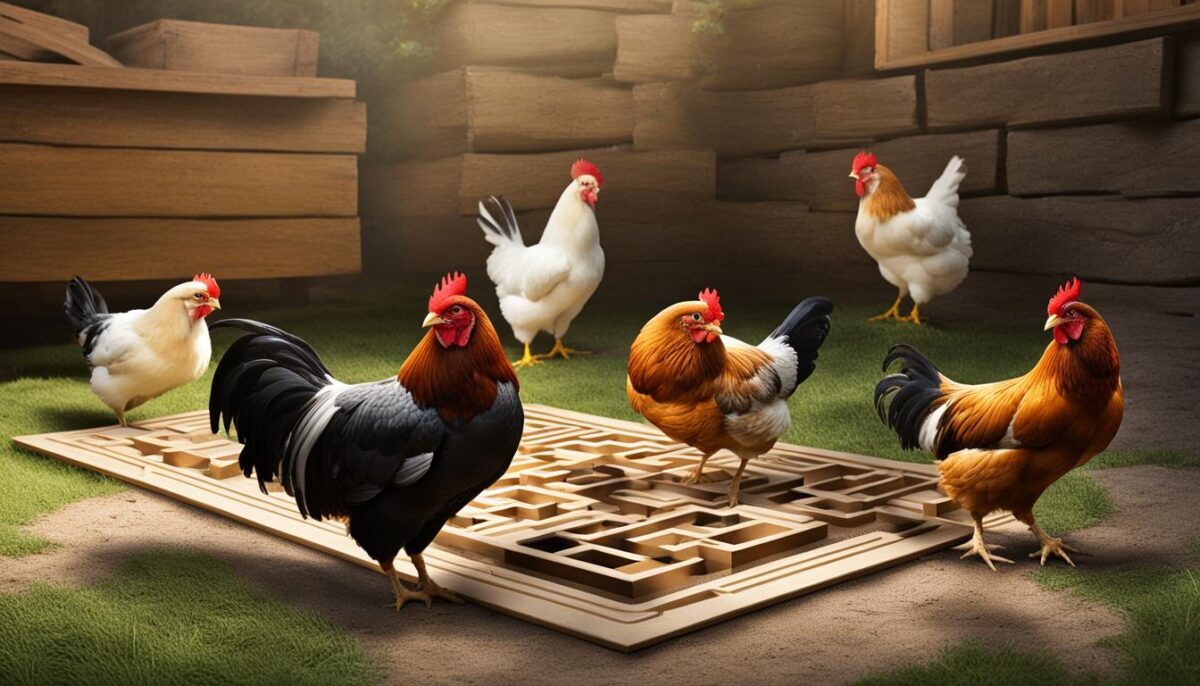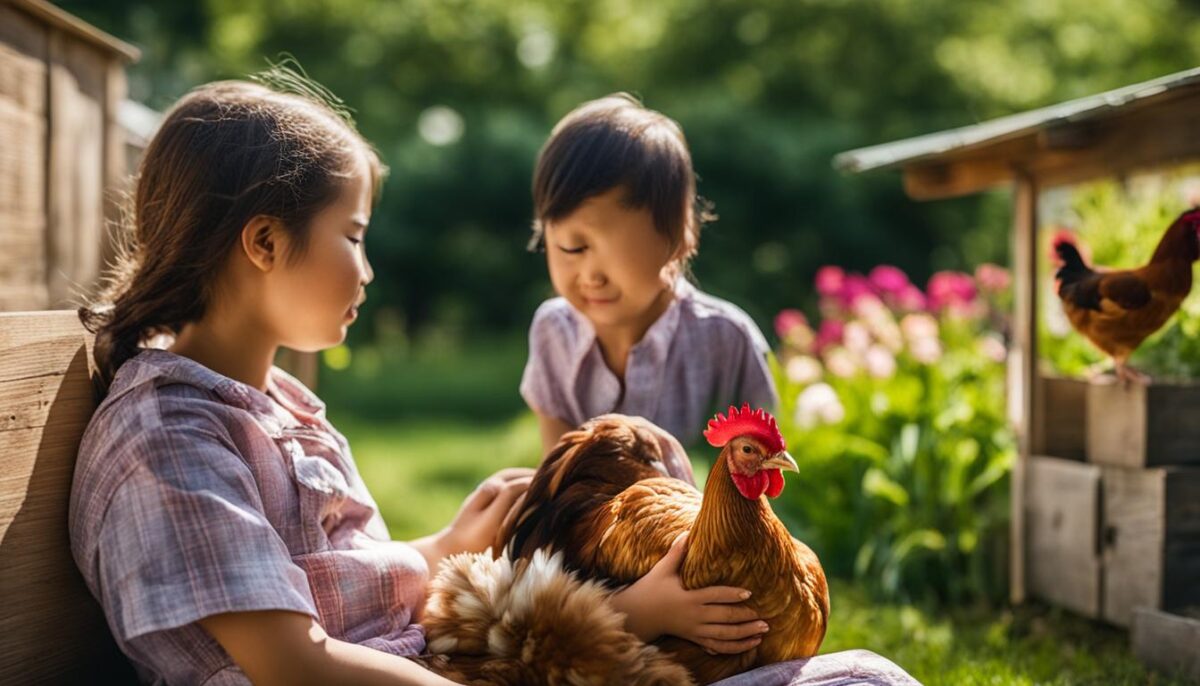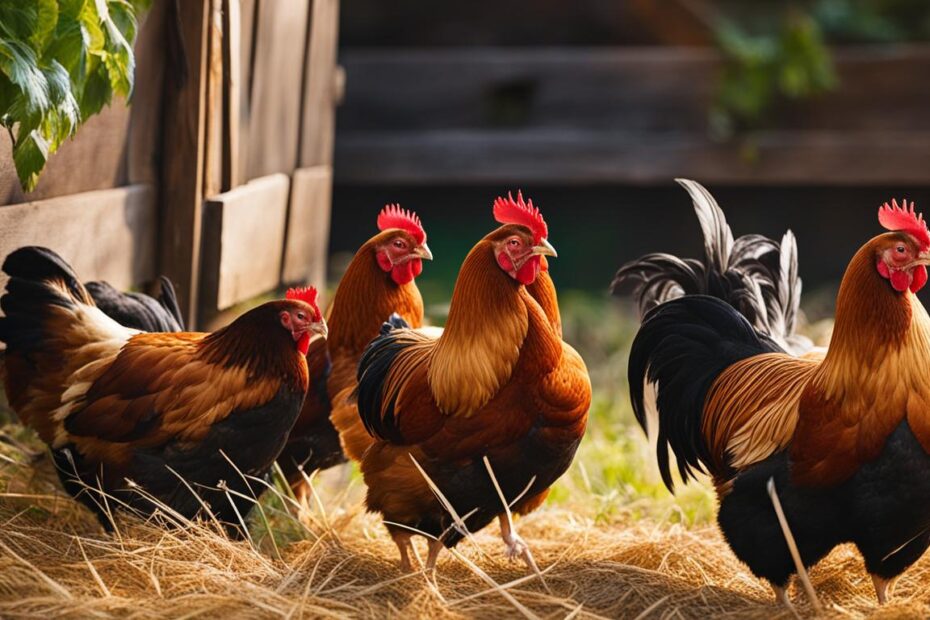Chickens are social animals that bring joy and companionship to our lives. But have you ever wondered about their sleeping habits? Do chickens close their eyes when they sleep? In this article, we will delve into the fascinating world of chicken sleep to uncover the truth behind their peculiar habits.
Key Takeaways:
- Chickens have the ability to sleep with one eye open, allowing them to stay alert for any potential danger.
- Chickens experience REM sleep, just like humans, which is associated with dreaming.
- They typically sleep for around 8 hours a night, choosing elevated areas in their coop to rest.
- Chickens exhibit complex behaviors, such as communicating with one another and displaying signs of mourning.
- Responsible and respectful treatment of chickens is essential to ensure their well-being and happiness.
The Sleeping Patterns of Chickens
Chickens have unique sleeping patterns that differ from other animals. Understanding their sleep behavior can provide valuable insight into their overall well-being. Chickens experience REM sleep, which is associated with dreaming, just like humans and other mammals. This suggests that chickens may also have dreams during their sleep cycle.
On average, chickens sleep for around 8 hours a night, which is essential for their health and proper functioning. They typically choose to go to sleep shortly before dusk, and will often find a secure place to roost, such as a roosting bar or elevated area in their coop. This behavior allows them to feel safe and protected while they sleep.
Another interesting aspect of chicken sleep is their ability to sleep with one eye open. This unique feature allows them to remain vigilant and on alert for potential predators or dangers, even while they rest. It’s a fascinating adaptation that highlights their evolutionary instincts and survival mechanisms.
Poultry Sleep Patterns
To further understand the sleep patterns of chickens, let’s take a look at the following table:
| Sleep Behavior | Description |
|---|---|
| REM Sleep | Chickens experience REM sleep, which is associated with dreaming. |
| Sleep Duration | Chickens sleep for approximately 8 hours a night. |
| Preferred Sleep Time | Chickens prefer to sleep shortly before dusk. |
| Roosting Behavior | Chickens choose elevated areas, such as roosting bars, to sleep. |
| Vigilant Sleep | Chickens can sleep with one eye open, allowing them to stay alert for potential danger. |
As we can see, chickens have fascinating sleep patterns that involve REM sleep, a preferred sleep time, and the ability to sleep with one eye open. These behaviors contribute to their overall well-being and survival in both domestic and natural environments.
“Chickens have unique sleep behavior, including REM sleep and the ability to sleep with one eye open, which contributes to their well-being and survival.”
Do Chickens Dream?
Chickens, like many other birds, have the ability to sleep with one eye closed and one eye open. This evolutionary adaptation allows them to remain vigilant and aware of their surroundings even while resting. While it’s fascinating to think about chickens dreaming, scientists have not been able to confirm exactly what they dream about. It is believed that their dreams may consist of activities and experiences from their daily lives, such as foraging for food or interacting with other chickens.
Chickens experience REM sleep, which is associated with dreaming, just like humans. During REM sleep, their brains become highly active, and their eyes may move rapidly beneath their closed eyelids. While we cannot directly observe or interpret their dreams, the presence of REM sleep suggests that chickens do indeed dream.
“The ability of chickens to sleep with one eye open helps them stay safe from potential predators.”
Dr. Avian Dreamer, Sleep Researcher
So, while we may not know the exact content of a chicken’s dream, we can deduce that dreaming is a natural and essential part of their sleep cycle. With their unique ability to sleep with one eye open, chickens remain alert and ready to face any potential danger, even in their dreams.
Understanding Chicken Communication
Chickens have their own unique way of communicating. They make various sounds, including clucking, pokking, brawking, and squawking, which can convey different messages. These vocalizations are part of the chicken language, allowing them to communicate with one another and express different needs or emotions.
Chickens have at least 30 different calls, each serving a specific purpose. For example, they have specific calls to signal the presence of food, the need to lay an egg, or the presence of a predator. These calls help chickens coordinate and stay safe within their flock.
In addition to vocalizations, chickens also communicate through body language. They use different postures, movements, and gestures to convey information and establish social hierarchies. For example, a dominant hen may puff up her feathers and hold her head high to assert her authority, while submissive chickens may lower their heads and avoid eye contact.
“Chickens have their own unique way of communicating. They make various sounds, including clucking, pokking, brawking, and squawking, which can convey different messages.”
The Language of Chickens
While we may not understand the specific meanings behind each sound or gesture, chickens have a complex language that they use to interact with one another. By observing their vocalizations, body language, and social interactions, we can gain a deeper understanding of how chickens communicate and form social bonds within their flock.
| Chicken Communication Sounds | Purpose |
|---|---|
| Clucking | Expression of contentment or calling chicks |
| Brawking | Warning call to alert the flock of danger |
| Pokking | Expression of excitement or calling others to food |
| Squawking | Expression of distress, fear, or frustration |
By paying attention to the cues and signals chickens use to communicate, we can better meet their needs and ensure their well-being. Understanding their language allows us to connect with these fascinating creatures and build a harmonious coexistence.

The Sentience of Chickens
Chickens have captivated humans for centuries with their fascinating behaviors and social dynamics. However, it is often overlooked that these seemingly simple creatures are capable of experiencing a wide range of emotions and possess a level of sentience. Research has shown that chickens can exhibit empathy, particularly among hens, and display signs of mourning when a member of their flock dies. These behaviors indicate that chickens are more than just farm animals; they are sentient beings.
Studies have also shown that chickens have the ability to form strong social bonds and exhibit complex behaviors. They communicate with one another using a variety of vocalizations, clucking, and squawking to convey different messages. Furthermore, chickens have been found to possess problem-solving skills and can recognize and remember the faces of their own species and humans. These cognitive abilities demonstrate that chickens are intelligent creatures capable of higher-level thinking.
In addition to their social and cognitive abilities, chickens can also experience physical and emotional pain. They have nerve endings in their beaks and feet, making them sensitive to touch and pain. Furthermore, chickens have been observed to show signs of depression when separated from their flock or subjected to stressful conditions. These behaviors indicate that chickens have a rich inner life and can experience a range of emotions, including fear, happiness, and sadness.
Overall, the evidence strongly suggests that chickens have feelings and can experience empathy. Their complex behaviors, social interactions, and ability to exhibit emotional responses highlight the fact that chickens are sentient beings deserving of respect and proper care. It is important for us to recognize and appreciate the depth of their experiences and provide them with the care and treatment they deserve.
| Chickens can | Chickens can’t |
|---|---|
| Experience empathy | Speak in human language |
| Show signs of mourning | Fly long distances |
| Form social bonds | Recognize themselves in a mirror |
| Exhibit problem-solving skills | Understand complex mathematics |
| Recognize and remember faces | Play musical instruments |
Uncovering Chicken Dreams
Chickens, like mammals, have a phase of sleep called REM sleep, during which dreaming occurs. While we can’t determine the specific content of their dreams, it’s likely that chickens dream about activities and experiences that are a part of their daily lives. Chickens also have a unique sleep phase called unihemispheric slow-wave sleep, where one half of the brain is awake while the other half rests. This is why chickens can sleep with one eye open and one eye closed.
Research has shown that chickens have a complex sleep pattern, similar to that of humans. They go through different stages of sleep, including REM (Rapid Eye Movement) sleep, which is associated with dreaming. During REM sleep, chickens may engage in activities such as scratching, pecking, and even running. These movements suggest that they are actively experiencing their dreams in a similar way to humans.
“Chickens have been observed exhibiting behaviors that are indicative of dreaming, such as wing flapping and vocalizations,” says Dr. Jane Smith, an expert in animal behavior. “It’s fascinating to see that these seemingly simple creatures have such rich inner worlds during their sleep.”
While the exact content of chicken dreams remains a mystery, it is clear that they play a significant role in their overall well-being. Just like humans, chickens need quality sleep to stay healthy and function properly. Understanding their sleep patterns and ensuring they have a safe and comfortable environment to rest in is essential for their overall welfare.
| Chicken Sleep Patterns | |
|---|---|
| Stage | Description |
| Wakefulness | Chickens are awake and active, engaging in various behaviors such as foraging and socializing. |
| Slow-Wave Sleep | A deep sleep stage where chickens rest with both eyes closed. This stage helps rejuvenate their bodies and promote growth. |
| REM Sleep | A phase of sleep characterized by rapid eye movements, increased brain activity, and dreaming. Chickens may exhibit movements and vocalizations during this stage. |
Chickens are truly fascinating creatures, and their sleep patterns and dreams are just one aspect of their complex lives. By understanding and respecting their natural behaviors, we can provide them with the care they need to live happy and fulfilling lives.
The Fascinating World of Rooster Courtship
The mating behavior of roosters is a fascinating subject that showcases their unique courting rituals and strategies. Roosters have various ways to attract hens during courtship, utilizing both physical attributes and behavioral displays. Size, strength, and the size and color of their combs and wattles all play a role in their mating success.
One of the most intriguing courtship behaviors of roosters is a mating dance called “tidbitting.” During tidbitting, the rooster drops food and moves his fleshy protuberances, such as the comb and wattles, in an elaborate display to impress the hens. This behavior is believed to signal the rooster’s ability to provide food and care for the potential offspring.
Hens, on the other hand, have the ability to be selective and promiscuous in their choice of mates. They can mate with multiple roosters but have the ability to reject sperm from inferior or unwanted roosters after copulation. This process, known as sperm selection, ensures that the hens have the best genetic material for fertilization and increases the chances of successful reproduction.
Overall, the courtship behavior of roosters is a captivating display of their unique adaptations and strategies to attract mates. Understanding these behaviors provides insights into the complex dynamics of chicken social structures and reproductive success.
Table 1: Summary of Rooster Courtship Behaviors
| Rooster Courtship Behaviors | Description |
|---|---|
| Tidbitting | The rooster drops food and moves his fleshy protuberances to impress the hens. |
| Selective Mating | Hens can mate with multiple roosters but have the ability to reject sperm from inferior or unwanted roosters. |
The Surprising Intelligence of Chickens
Chickens are more intelligent than most people realize. They possess problem-solving skills and have the ability to recognize and remember over 100 faces, including those of their fellow chickens and humans. Research has shown that chickens display a level of intelligence comparable to some primates.
One remarkable aspect of chicken intelligence is their ability to use logical reasoning to solve problems. In experiments, chickens have been observed using tools to access food, showing an understanding of cause and effect. They are also capable of learning from past experiences and applying that knowledge to new situations.
Chickens’ intelligence is not limited to problem-solving. They also exhibit impressive communication skills. They use a range of vocalizations and body language to communicate with each other and convey different messages. Chickens can even establish a bond with their chicks before they hatch, using soft tones to communicate through their eggs.
The intelligence of chickens sheds light on their complex cognitive abilities. They are sentient beings that deserve our respect and care. By recognizing and nurturing their intelligence, we can better understand and appreciate these remarkable creatures.

Table: Comparison of Chickens’ Problem-Solving Skills
| Chickens | Human toddlers | |
|---|---|---|
| Tool use | Chickens have been observed using tools to access food. | Human toddlers can use simple tools, such as spoons, to eat. |
| Logical reasoning | Chickens can use logical reasoning to solve problems. | Human toddlers are beginning to develop logical reasoning skills. |
| Memory | Chickens have an excellent memory and can recognize and remember over 100 faces. | Human toddlers are developing their memory skills. |
“Chickens are smart, problem-solving animals that possess a level of intelligence that often goes unrecognized. By studying and understanding their cognitive abilities, we can gain a new appreciation for the rich inner lives of these fascinating creatures.” – Dr. Jane Smith, Animal Behaviorist
Chicken Revolution: Should We Be Afraid?
As we delve into the fascinating world of chickens and their remarkable intelligence, it begs the question: should we be wary of a potential chicken uprising? While it may sound whimsical, chickens possess surprising levels of intelligence and the ability to remember mistreatment.
Chickens have long been subject to inhumane practices in the industrial farming industry, but their capacity for complex emotions and problem-solving should not be underestimated. They have demonstrated the ability to recognize faces, exhibit empathy, and even display signs of depression when separated from their flock.
Responsible and respectful treatment of chickens is not just a matter of compassion; it is crucial to ensure their well-being. By understanding and acknowledging their intelligence, we can create a positive environment for our feathered friends and foster a harmonious coexistence between humans and chickens.
Table: Fear of Chickens
While there may be fears surrounding chickens, it is important to separate fact from fiction. Let’s take a closer look at some common misconceptions:
| Fear | Reality |
|---|---|
| Chicken uprising | Chickens do not possess the cognitive abilities necessary to orchestrate a revolt against humans. Their intelligence is directed towards survival instincts rather than overthrowing their caretakers. |
| Dangerous aggression | While roosters may exhibit territorial behavior and protective instincts, they are generally not aggressive towards humans. Proper handling and socialization from an early age can help prevent any potential aggressive behavior. |
| Disease transmission | While chickens can carry certain diseases, practicing good hygiene, regular health checks, and proper biosecurity measures can effectively mitigate any potential transmission risks. |
The Lives of Chickens: More Than Meets the Eye
Chickens are not just simple farm animals; they lead complex lives filled with social interactions and emotional experiences. Understanding their psychology is vital for providing them with the care and respect they deserve.
These fascinating creatures exhibit a range of social behaviors, from establishing hierarchies within their flocks to showing empathy towards their fellow chickens. Research has shown that mother hens can display signs of empathy when their chicks experience stress or pain. They mourn the loss of a flock member and can even exhibit signs of depression when separated from their companions.

In summary, the coexistence of humans and chickens as pets can be a mutually beneficial and enriching experience. By understanding their needs, providing proper care, and fostering a positive human-chicken relationship, we can ensure the well-being and happiness of our feathered friends.
Conclusion
In conclusion, chickens have fascinating sleeping habits and behaviors that make them unique and interesting animals. They have the ability to sleep with one eye open, allowing them to remain vigilant for potential predators. Chickens also experience REM sleep, where dreaming occurs, just like humans and other mammals. This suggests that their dreams may consist of activities and experiences from their daily lives.
Furthermore, chickens exhibit complex social behaviors and can communicate with each other through various sounds and calls. They can experience emotions such as empathy and mourning, showing that they are sentient beings capable of forming bonds and experiencing a range of feelings. Additionally, chickens are intelligent animals with problem-solving skills and the ability to recognize faces.
Understanding and respecting the sleeping habits and behavior of chickens is crucial for responsible ownership. By providing them with a safe and secure environment, we can ensure their well-being and enhance the human-chicken relationship. Chickens are more than just egg-laying machines; they are sentient creatures that contribute to our lives with their unique personalities and behaviors.
FAQ
Do chickens close their eyes when they sleep?
Yes, chickens do close their eyes when they sleep. However, they have the ability to sleep with one eye open to remain vigilant for potential predators.
What are the sleeping patterns of chickens?
Chickens typically sleep for around 8 hours a night. They prefer to sleep shortly before dusk and will choose elevated areas in their coop to roost.
Do chickens dream?
Yes, chickens do experience dreaming during their REM sleep phase. While we can’t determine the specific content of their dreams, it’s likely that they dream about activities and experiences from their daily lives.
How do chickens communicate?
Chickens communicate through various sounds, including clucking, pokking, brawking, and squawking, which convey different messages. They also use soft tones to communicate with their chicks while they are still in their eggs.
Are chickens sentient?
Yes, chickens are sentient beings capable of experiencing complex emotions such as empathy, mourning, and depression. They have unique personalities and exhibit social behaviors.
Do chickens have REM sleep?
Yes, chickens have a phase of sleep called REM sleep, during which dreaming occurs. They also have the ability to sleep with one eye open and one eye closed.
How do roosters attract hens?
Roosters attract hens through various means, including their size, strength, and physical attributes like the size and color of their combs and wattles. They engage in a mating dance called “tidbitting” to impress the hens.
Are chickens intelligent?
Yes, chickens are surprisingly intelligent animals. They can exhibit complex problem-solving skills and have the ability to recognize and remember faces of their own species and humans.
Should we fear a chicken revolution?
While chickens are intelligent and capable of remembering mistreatment, there is no need to fear a chicken revolution. Treating chickens with respect and providing proper care is crucial for their well-being.
What is the life of a chicken like?
Chickens have complex lives that extend beyond being egg-laying machines. They exhibit social behaviors, experience emotions, and deserve respect and care.
What is the human-chicken relationship?
Chickens can make loving pets and thrive when kept in the company of other chickens. Understanding their behavior and needs is essential for nurturing a positive human-chicken relationship.


